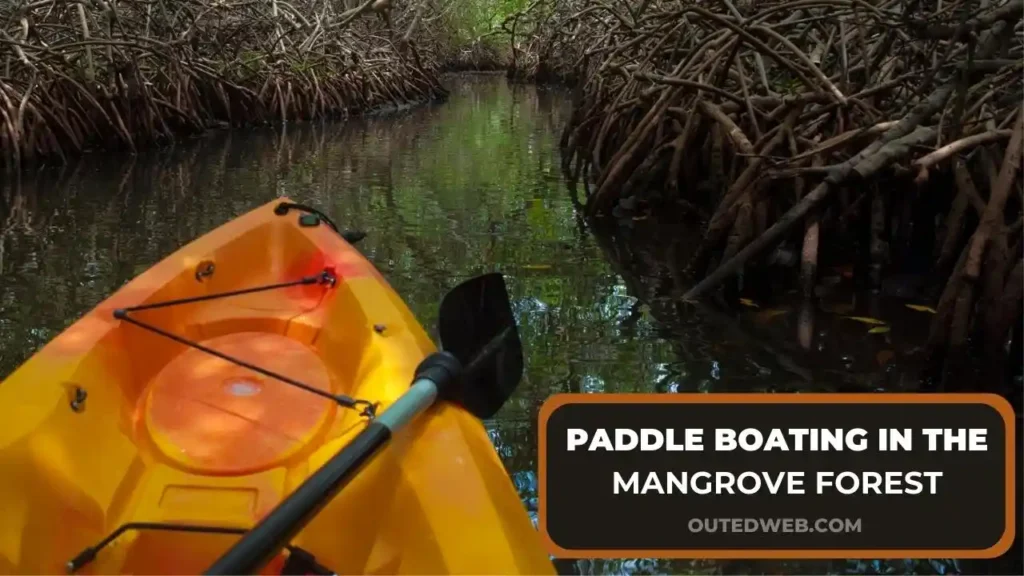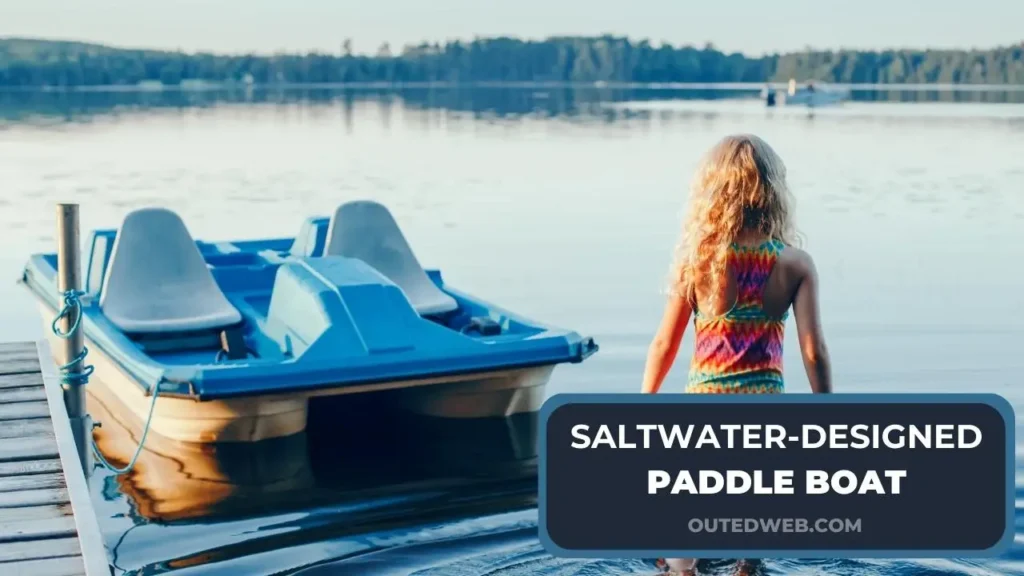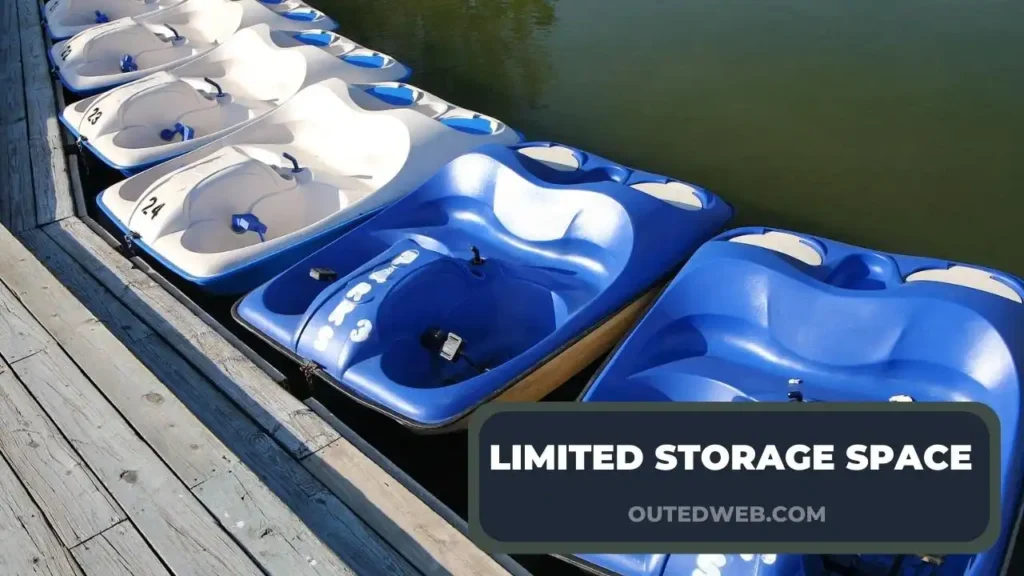It’s a gorgeous day in the summer, and you’re standing at the gleaming edge of a stunning saltwater bay. The gentle waves beckon you to explore its depths, but you’re faced with a dilemma. Can you use a paddle boat in saltwater? Will it withstand the harsh conditions and provide an enjoyable experience?
The answer is yes, you can use a paddle boat in saltwater! While paddle boats are commonly associated with calm lakes and tranquil rivers, they can venture into saltwater environments. Before you set sail, it’s critical to grasp the obstacles and implications of paddling in saltwater.
So, let’s uncover the possibilities and intricacies of using paddle boats in saltwater. Prepare to delve into the depths of this interesting topic and learn how to make the most of your salty sea paddle boat experiences.
Understanding Paddle Boats
In order to fully grasp the compatibility of paddle boats with saltwater environments, it’s essential to understand the intricacies of these versatile watercraft.
Paddle boats, also known as pedal boats, are human-powered vessels that rely on paddles or pedals to propel forward. They come in various designs and sizes, catering to different preferences and activities.
Types of Paddle Boats:
Paddle boats come in various designs, each offering unique features and capabilities. Here are some popular types:
Traditional Paddle Boats: These traditional paddle boats are great for recreational usage in calm waters like lakes and ponds because they have a wide, solid hull.
Pedal-Powered Kayaks: With the simplicity of pedal propulsion, these paddle boats combine the stability and agility of kayaks. They work well in a variety of water conditions for both fishing and recreational paddling.
Canoe-Style Paddle Boats: These paddle boats resemble canoes and offer ample space for multiple passengers or gear. They are great for family outings or extended fishing trips.
Stand-Up Paddle Boards (SUPs): While not technically paddle boats, SUPs deserve mention due to their increasing popularity. They provide a unique experience of standing on a board and paddling, offering a versatile platform for various water activities.
Read Related Articles:
Exploring Saltwater Environments
Saltwater environments offer a new dimension of exploration and adventure for paddle boat enthusiasts.
Paddle boats may give a unique and entertaining experience whether you wish to cruise along the coastline, visit mangrove forests, or fish in saltwater flats.
However, it’s essential to understand the characteristics of saltwater environments and the considerations involved in navigating them.
Coastal Paddling:
Paddle boating along the coast can be exhilarating, allowing you to enjoy stunning ocean views and access secluded coves and beaches. However, it’s crucial to keep the following in mind:
Tides and Currents: Coastal areas experience tides and currents, which can significantly affect your paddling experience. Research tide charts and current patterns to plan your trip accordingly and ensure you paddle with the current when possible.
Weather Conditions: Saltwater environments can be subject to changing weather conditions, including wind and waves. Stay updated on weather forecasts and avoid paddling in unsafe conditions. It’s also advisable to wear appropriate protective gear and carry a communication device for emergencies.
Mangrove Forests and Estuaries
Saltwater estuaries and mangrove forests are biodiverse ecosystems teeming with marine life. Paddle boating through these habitats can provide wildlife encounters and serene exploration opportunities. Consider the following:
Navigation Challenges: Navigating through narrow channels and dense mangrove roots requires maneuverability and attention to detail. Ensure your paddle boat is suitable for these environments, with a design that allows easy maneuvering in tight spaces.

Environmental Conservation: Saltwater ecosystems are delicate and vulnerable to human impact. Practice responsible boating by avoiding disturbing wildlife, refraining from littering, and adhering to local regulations or protected areas.
Saltwater Fishing:
Saltwater fishing from a paddle boat can be an exciting and rewarding experience. However, it requires some additional considerations:
Equipment: Ensure you have appropriate fishing gear, including a fishing rod holder and storage compartments for bait and tackle. Consider using a paddle boat specifically designed for fishing, with features such as built-in rod holders and stable platforms.
Safety: When fishing in saltwater, keep jagged reefs, powerful currents, and unexpected weather in mind. Stay updated on fishing regulations, obtain necessary permits, and follow safety guidelines to ensure an enjoyable and safe fishing experience.
Wildlife Encounters:
Dolphins, sea turtles, and a variety of fish species may all be found in saltwater habitats. While seeing animals can be exciting, it’s essential to respect their natural environment and keep a safe distance to prevent upsetting or endangering them.
Differentiating Between Regular And Saltwater-Designed Paddle Boats
Understanding the differences between regular and saltwater-designed paddle boats is crucial to ensure a safe and enjoyable experience on the water.
Regular Paddle Boats:
Standard paddle boats are typically constructed using materials like plastic or fiberglass, which are not specifically resistant to saltwater corrosion. As a result, prolonged exposure to saltwater can cause damage and deterioration. It’s essential to rinse the paddle boat with freshwater after each use and thoroughly dry it to minimize the risk of corrosion.
Saltwater-Designed Paddle Boats:
Some manufacturers offer paddle boats explicitly designed for saltwater use. These boats are constructed using marine-grade aluminum or stainless steel, more corrosion-resistant materials.

They often feature specialized coatings and finishes to enhance durability in saltwater environments. Saltwater-designed paddle boats can withstand harsh conditions and require less maintenance than regular ones.
Precautions And Maintenance Tips For Using Paddle Boats In Saltwater
Paddle boating in the refreshing saltwater environment can be a delightful and adventurous experience. However, to preserve the longevity and performance of your paddle boat, you must be aware of the special obstacles of navigating these waterways.
Rinse and Dry:
After each saltwater outing, thoroughly rinse the paddle boat with fresh water to remove any salt residue. Pay attention to all components, including the hull, paddle, and seating areas. Once rinsed, ensure the boat is completely dry before storage to prevent corrosion.
Lubrication:
To prevent corrosion brought on by exposure to seawater, apply a marine-grade lubricant on metal components including hinges, screws, and joints. The functioning and durability of these components are maintained by routine lubrication.
Protective Coatings:
Consider applying a marine-grade protective coating or wax to the paddle boat’s exterior. This additional layer acts as a barrier against saltwater and provides extra protection against corrosion and UV damage.
Storage:
The paddle boat should be kept dry and well-ventilated while not in use to reduce corrosion risk and moisture buildup. Additional protection can be provided by using a storage bag or a protective tarp to cover the boat.
Periodic Inspections:
Regularly inspect all components of the paddle boat, including the hull, seats, paddle, and any accessories. Look for signs of corrosion, damage, or wear and address them promptly to prevent further deterioration.
Pros and Cons of Using Paddle Boats in Saltwater
It’s essential to become informed about the benefits and drawbacks of this leisure activity before starting your saltwater paddle boat trip.
Advantages of using paddle boats in saltwater
Versatility:
Paddle boats offer a versatile and eco-friendly way to explore saltwater environments. They allow you to navigate shallow waters, narrow channels, and coastal areas that larger boats may be unable to access.
Fitness and Health Benefits:
Paddling a boat provides an excellent workout for the upper body, core muscles, and cardiovascular system. Engaging in regular paddling sessions in saltwater can contribute to improved fitness and overall well-being.
Wildlife Observation:
Saltwater environments are often teeming with marine life, including fish, birds, and other fascinating creatures. Paddle boats provide a quiet and non-intrusive means to observe wildlife up close, allowing for a more immersive and intimate experience.
Leisure and Relaxation:
Paddle boating in saltwater can offer a serene and tranquil experience. Whether you’re gliding along the coastline, exploring hidden coves, or enjoying a sunset paddle, the peaceful ambiance of saltwater environments can provide a sense of relaxation and rejuvenation.
Limitations And Considerations When Using Paddle Boats In Saltwater
Corrosion and Maintenance:
Saltwater can accelerate corrosion and wear on paddle boats, particularly if not explicitly designed for saltwater use. Regular maintenance and adherence to proper cleaning and storage procedures are necessary to minimize the effects of corrosion and prolong the boat’s lifespan.
Wind and Currents:
Saltwater environments are often subject to stronger winds and currents compared to freshwater bodies. Paddling against these forces can be more challenging, requiring greater physical effort and skill. Awareness of weather conditions and tides is crucial to ensure a safe and enjoyable experience.
Exposure to Elements:
Paddle boaters may be exposed to the sun, wind, and salt spray during saltwater adventures. Wearing suitable sun protection, such as sunscreen, sunglasses, and a hat, is crucial for your safety. It would be best if you also thought about utilizing waterproof gear to be dry and comfortable.
Limited Storage Space:
Paddle boats generally have limited storage space compared to larger vessels. This can be a limitation if you plan to carry a significant amount of gear or supplies. However, utilizing storage compartments efficiently and packing essentials can help overcome this limitation.

Navigation and Safety:
While paddle boats are relatively safe, being mindful of other watercraft, navigational markers, and potential hazards in saltwater environments is essential.
Understanding local boating regulations, obtaining necessary permits, and equipping yourself with safety gear, such as life jackets and signaling devices, are crucial for a safe and responsible saltwater paddle boating experience.
Final Say
While using a paddle boat in saltwater is possible, it requires careful consideration and proper maintenance. Understanding the limitations and taking necessary precautions will ensure a safe and enjoyable experience.
Saltwater-designed paddle boats are specifically crafted to withstand the corrosive nature of saltwater, offering enhanced durability and performance. Regular maintenance, including rinsing, cleaning, lubricating, and inspecting for damage, is essential to keep your paddle boat in optimal condition.
By following best practices and choosing a suitable paddle boat, you can confidently explore the beauty of saltwater environments. Always keep safety in mind, so keep an eye on the weather and follow local restrictions. Now, get ready to embark on exciting adventures and discover the wonders of paddle boating in saltwater!

